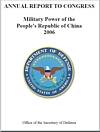Chinese Military Power: Can We Avoid Cold War?
 The Pentagon yesterday released its annual warning of the growing Chinese military threat. This year’s version continues the refrain from previous years and reiterates the conclusion from the recent Quadrennial Defense Review that China now is seen as the top large-scale military threat to the United States.
The Pentagon yesterday released its annual warning of the growing Chinese military threat. This year’s version continues the refrain from previous years and reiterates the conclusion from the recent Quadrennial Defense Review that China now is seen as the top large-scale military threat to the United States.
The signs of a Chinese threat are all there: An increasing defense budget that may equal half of ours in 20 years, new long-range mobile nuclear missiles that will be harder for us to destroy, an increase in the number of nuclear warheads that can hit the United States to perhaps as much as two percent of the warheads we can hit them with, new cruise missiles similar to the hundreds of cruise missile we have deployed in the region for decades, warships that may be able to disturb the unhindered operations of our carrier battle groups and surface action groups, a handful of nuclear-powered attack submarines that our 30 nuclear-powered attack submarines in the Pacific will have to sink too, more fighters and bombers that will be harder for the hundreds of advanced fighters we have deployed in the region for decades to shoot down.
This year’s Pentagon report dedicates more space than previous versions to discussing the big unknown: will China abandon its policy not to use nuclear weapons first? Of cause, there is “no evidence that this doctrine has actually changed” and China’s senior leadership assured Rumsfeld in 2005 that it “will not change,” the report states. Yet the attention this issue gets in the report suggests that the Pentagon suspects a change is underway. The circle of “military and civilian national security professionals” that discuss the value of the no-first-use policy “is broader than previously assessed,” the report hints.
Just imagine if China had a nuclear policy like the United States: a first-use nuclear doctrine with highly-accurate flexible nuclear forces on high alert, many of them forward deployed, capable of conducting a decapitating preemptive first strike. That would be highly destabilizing.
So let’s try not to get to that situation. Unfortunately, after having targeted China for 50 years, the Pentagon is reacting to China’s military modernization in the old-fashioned way: moving the majority of its nuclear ballistic missile submarines into the Pacific, increasing the number of attack submarines operating in the region, and forward-deploying bombers and cruise missiles to Guam. It has even built a whole new war plan, known as Operations Plan (OPLAN) 5077, according to Willliam Arkin, to defend Taiwan which includes options for attacks on the Chinese mainland, even the potential use of nuclear weapons.
Last time we got into this tit-for-tat game with a large military power it took 50 years, trillions of dollars, and several nuclear crises to get out. The Pentagon’s report on China’s military modernization should warn us that it is important that the White House and Congress take charge of U.S.-Chinese relations so we avoid a new Cold War in the Pacific.
See also: Chinese Nuclear Forces, 2006 | China’s Nuclear Submarine Cave
The Federation of American Scientists applauds the United States for declassifying the number of nuclear warheads in its military stockpile and the number of retired and dismantled warheads.
North Korea may have produced enough fissile material to build up to 90 nuclear warheads.
Secretary Austin’s likely certification of the Sentinel program should be open to public interrogation, and Congress must thoroughly examine whether every requirement is met before allowing the program to continue.
Researchers have many questions about the modernization of Pakistan’s nuclear-capable aircraft and associated air-launched cruise missiles.